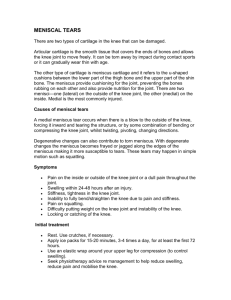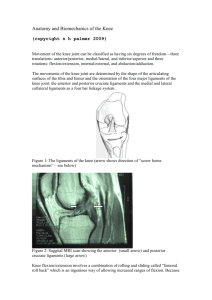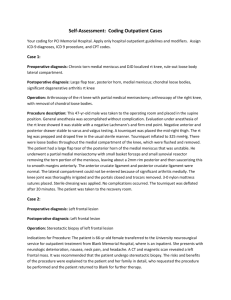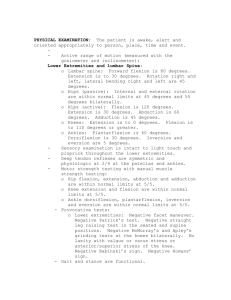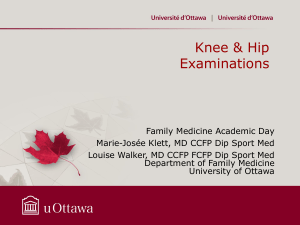Sports Medicine
advertisement
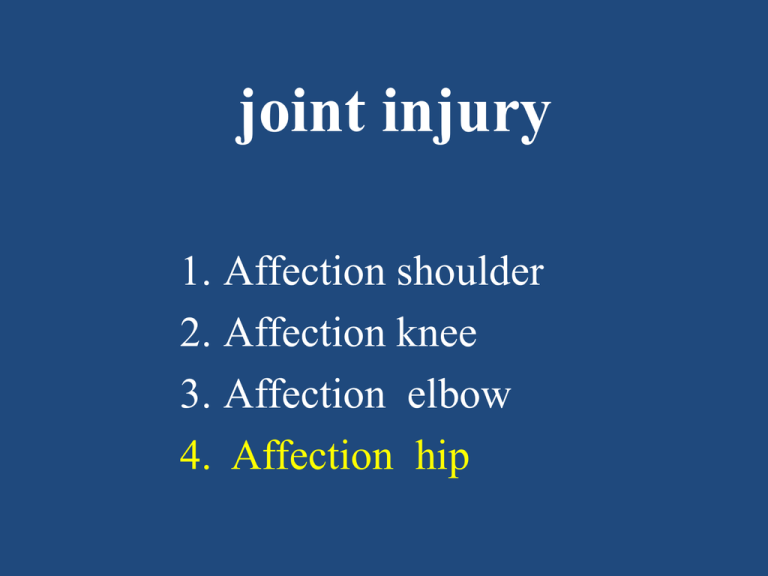
joint injury 1. Affection shoulder 2. Affection knee 3. Affection elbow 4. Affection hip Affections of shoulder I. Anatomy 1. joint of shoulder 1> acromio-clavicular joint : disc 1) acromio-clavicular lig: disc 2) coraco-clavicular lig: coronoid & trapezoid lig. 2> sterno-clavicular joint 3> scapulo-thoracic joint 4> gleno_humeral joint: compare with head glenoid cavity is small and thin cause wide ROM but unstable. 2. Ligaments from coronoid process 1> coracohumeral lig. 2> coracoacromial lig. 3> coracoclavicular lig. 3. Movement of the shoulder joint 1> flexion: 2> extension: 3> abduction: 1) ant. Fiber of deltoid 2) coracobrachialis 1) latssimus dorsi 2) teres major 1) deltoid 2) supraspinatus 4> horizontal abduction: 1) post. Fiber of deltoid 5> horizontal adduction: 1) pectoralis major 6> external rotation: 1) infraspinatus 2) teres minor 7> internal rotation: 1) subscapularis II. Biomechanics glenohumeral motion scapulothorcic motion eg) abduction 180°= gelnohumeral motion 90 110° + scaulothoracic motion 70-90 ° *clavicle motion: 40-60 ° III. Thoracic outlet syndrome 1> cervical rib syndrome 2> scalenus anticus syndrome 3> costoclavicular syndrome 4> hyperabduction syndrome anatomy upper middle lower 1>scalenus anticus 2>scalenus medicus 3>1st rib 1>1st rib 2> clavicle 1> coracoid process 2> pectoralis minor 3>coracoid membrane 1. Cervical rib syndrome -characteristics: from 7th cervical spine -anatomy: 1>bone or fibrous band 2>brachial plexus &subclavian a. -> over cervical rib going through the cervical rib & scalenus space. 3>c8 & T1 compression -Symptom: 1> pain or radiating pain to medial side of shoulder, forearm 2> paresthesia in ulnar N. area 3> radial A. pulse weakness Adson’s test: is the loss of the radial pulse in the arm by rotating the head to the ipsilateral side following deep inspiration Diagnosis 1> simple X-ray 2> arteriograph: valuable Tx: 1> conservative: Posture correction and shoulder girdle strengthening exercises for the muscles, working posture, changes in sleeping habits. 2> operative: 1)cervical rib rimoval 2)scalenus anticus resection 3) Ist rib resection 2.Scalenus anticus syndrome -anatomy: abnormal hypertrophied scalenus -characteristic: 1)Prevalent in middle age 2)later than cervical rib syndrome 3) Prevalent in women (female) Sx & sign: similar with cervical rib syndrome Diagnosis: 1>angiography 2>MRI: scalenus anticus – hypertrophy Tx: 1>conservative : 2>operative 3.Costoclavicular syndrome -anatomy; clavicle &1st rib space –narrowing or deformity d/t 1)cerviothoracic scoliosis 2)clavicle fracture 3)nonunion or excessive callus of 1st rib 4)occupational problem 5)atrophy of m. of shoulder girdle -Wright test(=costoclavicular maneuver) : 4.Hyperabduction syndrome -anatomy: over abduction upper arm->teres minor tension->neurovascular structure tractioned by over hanging coracoid process d/t 1) repetitive trauma of neurovascular structure -Hyperabduction test *also positive at normal population Tx: 1) conservative: posture correction 2) operative: release or resectomy IV. Subacromial Syndrome • Subacromial space: • Subacromial bursa: • Subteltoid bursa: 1.Supraspinatus tendinitis rotator cuff : 1,2,3,4, d/t rotator cuff ->degenerative change Mechanism: 1. upper arm abduction 2.supraspinatus glipped at humerus greater tubucle &acromion 3. With aging protection of the bursa weak, and continued trauma mechanical stimuli and inadequate recovery 4.supraspinatus –early phage wear,local ischemia, inflammation stage, calcification Acute inflammation stage(=chemical furuncle) -acute calcareous tendinitis; calcifications - 25-45 yrs - rotation, abduction ->limitation sagital plane motion -> not limited Chronic tendinitis(=painful arc syndrome) -50-60yrs -shoulder jt, 60-90°abduction-> contact with acromion lesion site-> pain D/Dx: degenerative artiritis of acromioclavicular joint (90°이상의 전범위) 2.Bursitis Subacromial bursitis -supraspinatus lesion->scar tissue->bursal hypertrophy -Snapping shoulder : coracoacromial lig. -Dawbarn’s sign; pain at greater tubercl of humerus , when over abduction ,bursa placed at under acromion, pain release. subcoracoid bursitis subscapular bursitis 3.Impingement Syndrome -Subacromial space : humeral head ->acromion -Rotator cuff 1)supraspinatus 2)infraspinatus 3)teres minor 4)subscapularis -shoulder pain was main reason d/t degenerative change of rotator cuff Stage of impingement syndrome Stage I Pathology : Typical age: Clinical course: Edema & Hemorrhage <25 Yr Reversible Conservative Treatment: Stage II Stage III Fibrosis & Tendinitis 25-40 Yr Recurrant pain with activity Consider operation Bonspur & Tendon rupture >40 Yr Progressive disability Ant. Acromioplasty &rotator curr repair Mechanism : 1. Upper limb abduction 2. Supraspinatus clipping between humerus great tubercle & acromion 3. With increasing age the protection of the bursa was weak, ongoing trauma due to mechanical stimulation and inadequate recovery 4. Supraspinatus early wear, local ischemia, inflammation, calcification *Dawbarn’s sign: pain at humerus great tubercle painless when complete abduction-> bursa placed at sub acromion. Sx & sign • Night pain (Characteristic) • Pain at: 90° abduction; sudden arm flexion • Impingement sign: 90°flexion &internal rotation upper arm • Always combined Secondary biceps longhead rupture with supraspinatus rupture Dx: 1.shoulder series X –ray: 1) sclerosis around acromion 2) sclerosis &cystic change around greater tubercle 2.athrogram 3. MRI Tx. 1. Conservativ Tx. 2. Operative Tx. : after conservative Tx 3Ms, still have symptom. 1) ant. acromioplasty 4.Rupture of supraspinatus tendon - Trauma history - Degenary change : essential prerequisite rupture - Partial tear : self healing possible Complete tear (x) - 45-65 yrs Sx & sign: -supraspinatus single rupture: abduction possible -rotator cuff widely rupture: abduction impossible *shrugging: abduction impossible, attempt to abduction *abduction paradox: *drop arm sign: Tx. - 90% non surgery healing Partial rupture: conservative Tx Complete rupture: conservative Tx at once->operative Tx Old rupture: not need surgery 5.Tenosynovitis of Biceps 40yrs Female digging or throwing ball Sx & sign -direct pain in groove of biceps long head tendon -Speed test: elbow jt. Extension & forearm supination, flexion shoulder jt. Under Constant resistance ->pain -Yergason’s test: elbow jt. Flexion, supination forearm under Constant resistance ->pain Tx.: - conservative Tx. - operativer Tx. Adhesive Capsulitis, Frozen Shoulder 1. intrinsic factor 1)calcareous supraspinatus tendinitis 2)partial tear of rotator cuff 3)biceps tendinitis 4)prolonged immobilization 2. extrinsic factor 1)myocardial infarction 2)HIVD in cervical spine 3)CVA 4)reflex sympathetic dystrophy -45-60yrs. Sx & sign 1)pain: aggrevated by abduction, E/R, extension 2)stiffness 3)tenderness: Inferior shoulder Tx. - several months Physical Therapy - important to convince the patients it may fully recovered - conservative Tx. 1)thermal therapy 2)exercise : pendulum exercise -> finger tip wall climbing exercise (A/A movement) 3) NSAID, steroid Humeral Lateral Epicondylitis (tennis elbow) Charac: 1) humeral lat. Epicondyle origin common extensor tendon fiber contusion 2) tennis, golf hitting the ball moment , elbow have the varus force; When the extensor muscle tensioning in semipronation and racket is designed for faster than expected rush to elbow flexion and forearm extensor muscle at the moment is to hyperextension occurred Sx: 1) Turn the knob / twist a towel 2) Kettle holding the handle 3) Forearm caracole top of the hard lifting heavy objects Tx: 1.conservative Method 1)NSAID 2)Procaine +25mg Hydrocortisone : local inj 1-2 time 2. operative method Trigger Fignger & Thumb Charac: 1) thumb or finger, flexion or extension limitation at an angle +snapping sound 2) d/t trauma of rheumatoid synovitis Patho: 1) localized stenosis of flexor tendon sheath, located near the MP jt 2)2nd: nodular thickening of the tendon ->disturbing smooth sliding in tendon sheath Tx: 1) cast splint & hydrocortisone 2)MP jt area skin transverse dissection ->A 1 pulley(1st annular pulley) longitudinal incision -> stenosis site open & removal Avascular necrosis of the hip 1.Symptomatic a.Traumatic (Neck fracture,dislocation) b.Embolism (decompression sickness, Siconkle cell anemia, Gaucher’s disease) c.postirradiation 2.Idiopathic – fat embolism, vascular lesion, coagulation defect 3.Male : female = 3:1 4.Sclerosis and lucency, Subchondral fracture (Cresent sign) 5.Core decompress, living bone graft, rotational osteotomy, arthroplasty Anatomy Affections of Knee 1. lateral qudaruple complex of Nicholas : lateral collateral lig., illiotibial band, biceps femoris tendon, popliteus tendon 2. Medial quadruple complex : medial collateral lig., semimembranosus, pes anserine muscle, oblique popliteal lig. 3. Semilunar cartilage (meniscus) : transmit about half the axial loa across the joint lateral meniscus more wide , O type ; medial meniscus more big 4.ligaments strength : tibial collateral =ACL= 1/2PCL function: ACL: prevent tibia anterior translation & hyperextension; contr rotation of femur to tibia PCL: prevent tibia posterior translation to femur Injury of Meniscus 1.Type I col Component: collagen: radially, longitudinally or circumferential Longitudinal fiber –dispersion hoop stress Radial ,longitudinal fib --- indure compressive force 2.Proteoglycans: absorb energy Medial meniscus • C- shaped structure: bigger than LM • Big Posterior Horn • Most of weight loading transmit to posterior horn • Whole peripheral border : firmly attached to the medial capsule and through the coronary ligament to the upper border of the tibia Lateral meniscus • More circular in form , thicker inperiphery • Covering up to 2/3of the articular surface of the tibia plateau • Ant. Horn: attached to the tibia medially in front of intecondylar eminance • Post. Horn: inserts into the post aspect of the intercondylar eminence and in front of the posterior attachment of the medial meniscus • Ligament of Wrisberg and ligament of Humphry • Tendon of popliteus: enveloped in a synovial membrane forms an oblique groove on the lateral border of the meniscus Function of Meniscus 1.Provision of stability 2.Shock absorption 3.Provision of increased congruity 4.Aids lubrication 5.Prevents synovial impingement 6.Limits extremes of flexion & extension 7.Tranmits loads across the joint --50% to 100% of load is transmitted through the menisci 8.Reduce contact stresses Physiologic condition • Lateral meniscus carries most of the load in the lateral compartment • Medial meniscus and the exposed articular cartilage shares the load almost equally in medial compartment Blood circulation • Blood capillary supply: periphery 1/3 of the menisc • Diffusion from the joint fluid: inner 2/3 The thickest central part of the meniscus farthest from the nutritional pathways is prone to degeneration Predisposing factor of meniscus injury • • • • • Peripheral cystic formation Limited mobility by prejury or knee pathy Congenial anomaly : discoid meniscus Degeneration Abnormal mechanical axis in joint with incongruity • Congenital relaxed joint • Inadequate musculature Injury of meniscus Mechanism: internal rotation of femur to tibia Type : 1) Longitudinal tear 2) Transverse tear 3) Horizontal tear 4) Others Symptom: 1)pain, tenderness(joint line tenderness) 2) limitation of motion (extension disability) 3) Locking: sudden extension limitation 4)giving way 5) Quadriceps atrophy (esp: Vastus medialis) Menisci tear Menisci tear in MRI • • • • Double PCL sign Vacant sign of medial joint space Central displacement of the fragment Flipped meniscus MRI: Sensitivity 93% Specificity 84% Fig Physical Exam: 1)Mcmurray test medial meniscus tear: tibial ext. rotation+adduction lateral meniscus tear: tibial int. rotation + abduction 2)Apley test; distaction test: ligament inj. glinding test: meniscus inj. 3)Squatting test: Dx.:Athrogram, MRI , Athroscope Tx. 1) Conservative Tx.: splint, NSAID, quadriceps exercise 2) Operative Tx.: athroscopic menisectory(partial , total) athroscopic meniscal repair, open menisectomy Indication of Meniscus repair 1. Vertical longitudinal tear 2. Above 1cm unstable tear 3. Normal condition of neighbouring 4.Vasculor zone tear: MM 30%, LM 25% 5. Under 40yrs , active Structure of protect in repair 1.MM: Sartorial branch of femoral nerve infrapatella branch of Saphenous nerve :flexon of knee 5—15degree 2.LM:peroneal nerve:flexion 90degree, figure-four position 3. Post. Horn:poplitel artery & vessel Meniscal suture technique • Anterior horn: out side to inside technique • Mid portion: Inside to outside technique • Posterior horn: All inside technique Discoid meniscus - most in lateral meniscus - unexplained - over exercise & thickening -> tear Meniscal cyst - young age , lateral meniscus - knee extension: palpable a lateral knee mass flexion : not palpable Tibial collateral ligment External rotation beyond 45°-> disruption of the medial capsular lig. External rotation beyond 45°+abduction -> disruption of the tibial collaterl lig. External rotation beyond 45°+abductjion after the tibial collateral lig. Is torn -> disruption of the ant. Cruciate lig. *Unhappy triad of O’Donoghue: ext.rot. + abd. : MCL ruption + medial meniscus injury + acl tear DX.: Stress test : 30° flexion knee and valgus stress Stress roentgenogrphy: when stress test checking AP X-ray < 5 mm: mild, 5-10mm: moderate , >10mm: severe Tx.: mild: elastic bandage, cast splint, cylinder cast (3-4weeks) Moderate: long leg cast Severe: early operation Lateral collatral ligament Tibia int. rotation + varus stress +stumble forward The frequency : low Severe : Iliotibial band, PCL, ACL, Peroneal nerv Anterior cruciate ligament Instability : full extension: ACL, PCL , MCL, LCL Flexion: ACL, PCL Acl= AM band + PL band Extension: AM , PL Flexion: only AM Most relaxed at flexion 40-50°with rot. -> tension ↑ Tear site : middle bundle > femoral attachment > tibia attachment Combined : LM or MCL tear Mechanism: 1> External rotation & abduction with knee 90 ° flexion 2> Complete dislocation of the knee joint 3>Direct posterior force against the uper end of the tibia. 4>Internal rotation of the tibia while the knee is extended. Sx.: Pop sensation, hemorrhage, swelling Test; 1)anterior drawer test 2)Lachman’s test: 3)Pivot shift test, Mcintosh test, Slocum test ,losee test Dx.: Tx: PE, MRI, Athroscopic exam - conservative: brace cast, muscle strengthening exercise - surgery: bone-patella tendon-bone complex, semitendinosus, iliotibial band, allo graft Posterior cruciate ligment injury Basic stabilizer of knee, prevent hyperextension, prevent posterior tranlation & int rotation of tibia when knee flexion, prevent varus and valgus angulation at knee extension Composed : anterolateral &posteromedial band Tensioning: flexion : anterior portion extension: posterior Mechanism: 1) severe rotational injury: external rotation-valgus injury or an internal rotation-varus injury 2) Hyperextension injuy: 3)Direct trauma to the upper tibia while the knee is flexed( posterior translation) 4)Complete dislocation Osteochondritis dissecans • OCD is caused by blood deprivation in the subchondral bone. • This loss of blood flow causes the subchondral bone to die in a process called avascular necrosis. The bone is then reabsorbed by the body, leaving the articular cartilage it supported prone to damage. • The result is fragmentation (dissecans) of both cartilage and bone, and the free movement of these osteochondral fragments within the joint space, causing pain and further damage • joint pain in physically active adolescent • Common reason of foreign body of joint • Lateral wall of medial femur condyle • Insidious onset, pain even at rest, and aggreviated by exercis Recurrent dislocation of the patella • Dislocation , subluxation Sx.: patellofemoral degenerative arthritis Dx.: Apprehension test: Chondromalacia Patellae • Softening of the articular cartilage Sx.: Diffuse pain over the front or anteromdial aspect of the knee made worse when the knee functions under load in flexion, such as when going up and down stairs. Patella compression test: at knee fexion Tx.: - avoiding stair climbing, keeping the knee fully extended while sitting and avoiding squatting - Quadriceps resisitive exercise Osgood-Schlatter’s disease 1. Sudden traction- > partial seperation -> epiphysis of the tibial tuberosity 2. bilateral , 10-15 male 3.swelling, tenderness, pain at active knee extension 4.Xray: multiple fragmented area of ossification ossification center of tubercle -> prolonged distally 5.Tx.: conservative Tx. extension knee long leg cast, restriction of activity Is there effusion? Patellar Palpation/Tilt/Apprehension Lachman Valgus/Varus Stress McMurray’s Test Apley’s Test Symptom: anterior ankle pain, swelling after activity, limited dorsiflexion Dx: Clinical , based on physical examination -local pain on palpation is present anteriorly, And osteophytes maybe palpable with ankle joint in slight plantarflexion -pain on palpation is predominantly located anteromedially – anteromedial impingement -pain on palpation is predominantly located anterolaterally- anterolateral impingement X-ray: Ferkel view normal tibiotalar angle is 60 °or more angle less than 60 ° may indicate bony impingement Tx: conservative treat: resting, NSAIDS, injection, hill lifts Surgery: Resection of osteophyte and inflamed soft tissue --Tarsal and tibial osteophytes decrease anterior space, compression of soft tissue component is likely to occur --Therefore important to remove these osteophytes restoring anterior space and reducing chance that symptoms recur Painful heel syndrome Proximal plantar fascitis Ankylosing spondylitis sex F>M (2times) M>F (3times) Age Average 45yrs 2nd &3rd decade Onset after age 40 unusual Tenderness Medial calcaneal tuberosity Tendon insertion site Systemic Sx. None Back pain , uveitis Aortic insufficiency Inflammatory disease etc. Activity Pain aggravation relief Heel spur (+) 50% (-) Sx Firs step pain Morning stiffness HLA –B27 (-) (+) site Bilateral
